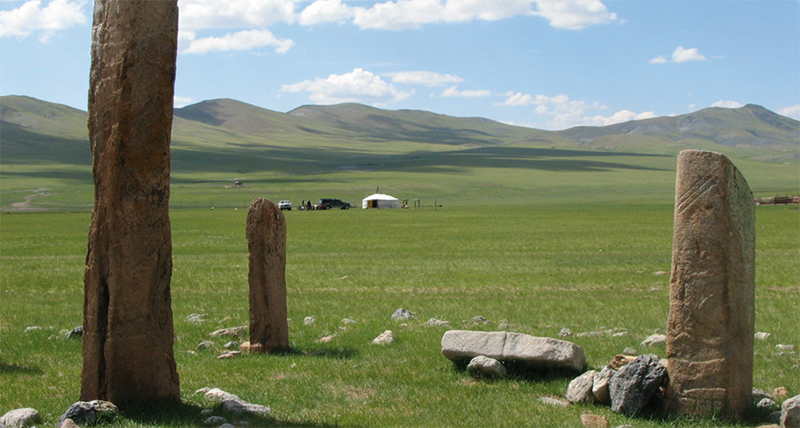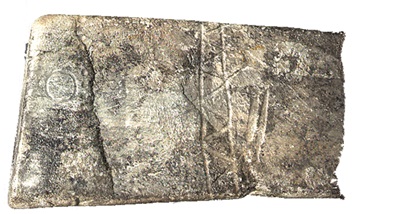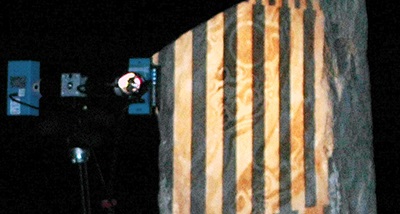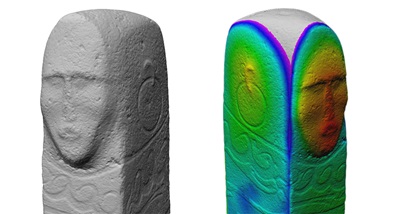Scanning for the American-Mongolian "Deer Stone Project"
Smithsonian Museum Conservation Institute - USA
Contact us

Long distances, extreme temperature differences and adventurous transport conditions: The “Deer Stone Project”, a cooperation of the Smithsonian Museum Conservation Institute (Washington, USA) and Mongolian scientists, has presented exceptional challenges on mankind and technology alike. High-precision 3D scanning technology by AICON was put to the test by scanning carved stone monoliths dating back to the Bronze Age located in the province of Hovsgol Aimag in Nothern Mongolia.
Objective and measuring object
 In the summer of 2007, an expert archaeological expedition set out to conduct a detailed three-dimensional scanning project of the so-called Deer Stone monoliths which date back to the 1st to 2nd millennium BC. The primary objective for the 3D acquisition of these monoliths was to promote the understanding and preservation of these historically significant monuments. Until then, the stones have only been rudimentarily documented and the continued risk of disintegration by environmental and human causes has called for special measures. The technique of non-contact 3D imaging provides the possibility to generate precise, high-resolution metrological information on site, thus creating highly accurate 3D images of each object. In conjunction with other types of documentation, these digital records constitute valuable material for research, educational and archiving purposes as well as for the production of replicas.
In the summer of 2007, an expert archaeological expedition set out to conduct a detailed three-dimensional scanning project of the so-called Deer Stone monoliths which date back to the 1st to 2nd millennium BC. The primary objective for the 3D acquisition of these monoliths was to promote the understanding and preservation of these historically significant monuments. Until then, the stones have only been rudimentarily documented and the continued risk of disintegration by environmental and human causes has called for special measures. The technique of non-contact 3D imaging provides the possibility to generate precise, high-resolution metrological information on site, thus creating highly accurate 3D images of each object. In conjunction with other types of documentation, these digital records constitute valuable material for research, educational and archiving purposes as well as for the production of replicas.
Measuring system and setup
 A preceding model of the AICON SmartScan was chosen for all scanning tasks during this field trip project. This system is especially designed to fulfil the demanding requirements in connection with the three-dimensional data acquisition of objects in arts and cultural heritage: It does not only deliver precise 3D models at a prime level of resolution and accuracy, but moreover allows for texture mapping of the object surface in the object’s authentic colour. Among other applications, this 3D scanner is widely used in the field of archaeology and for the data capture of historical monuments.
A preceding model of the AICON SmartScan was chosen for all scanning tasks during this field trip project. This system is especially designed to fulfil the demanding requirements in connection with the three-dimensional data acquisition of objects in arts and cultural heritage: It does not only deliver precise 3D models at a prime level of resolution and accuracy, but moreover allows for texture mapping of the object surface in the object’s authentic colour. Among other applications, this 3D scanner is widely used in the field of archaeology and for the data capture of historical monuments.
The AICON SmartScan consists of a sensor bar fitted with a projector unit and a colour camera (1,384 x 1,036 pixels) mounted onto a tripod, a calibration plate, and a control unit. The camera lenses are interchangeable, allowing the system to be adjusted to varying fields of view (FOV). In this case, lenses for a FOV of 675 mm were used. In conjunction with a laptop and an electric power generator, the AICON Scanner has proven to be perfectly suited for the task even under the most challenging circumstances.
Workflow
 Depending on the weather conditions as well as the schedules of the various archaeological teams involved, the 3D digitisation of the Deer Stones was conducted during day and night time. A structured light scanning system is very susceptible to interferences caused by ambient light. To ensure high quality scanning results under day time conditions, the Deer Stones and the 3D scanner had to be covered with a large tent to create a shield against any exposure to interfering ambient light. Whenever possible, night time scanning was chosen as the preferred and by far more effective option naturally providing ideal lighting and contrast conditions.
Depending on the weather conditions as well as the schedules of the various archaeological teams involved, the 3D digitisation of the Deer Stones was conducted during day and night time. A structured light scanning system is very susceptible to interferences caused by ambient light. To ensure high quality scanning results under day time conditions, the Deer Stones and the 3D scanner had to be covered with a large tent to create a shield against any exposure to interfering ambient light. Whenever possible, night time scanning was chosen as the preferred and by far more effective option naturally providing ideal lighting and contrast conditions.
After completion of the entire scanning process, all individual scans of a Deer Stone were aligned based on the 3D surface geometry of the digitised object without the use of additional reference marks. Subsequently, the individual scans of the point cloud were merged and converted into a PLY file which is designed to save the generated 3D data together with respective colour information, surface normals, and texture coordinates. After having merged the single scans, any holes found in the 3D data mesh were filled. The finalised data files were then saved again as a new PLY file, ready for transfer to specialised software programs for further processing.
Conclusion
 Over a period of three weeks, fifteen of the 3,000 years old Deer Stones have been completely digitised and respective high-resolution 3D records have been generated. The height of the stones ranged from 0.5 up to 3.0 meters; the digitisation was carried out during day and night as well as under extreme temperature differences (32° F to 122° F). Despite the adventurous transport route of more than 1,200 miles across predominantly rough and difficult terrain, the robust AICON Scanner has proven to be the perfect scanning solution to deliver dependable, high-resolution measurement results even under the most challenging conditions. Even the fine dust, blown daily across the Mongolian steppes by fierce winds, did not in the slightest way affect the accuracy and quality of the 3D scans.
Over a period of three weeks, fifteen of the 3,000 years old Deer Stones have been completely digitised and respective high-resolution 3D records have been generated. The height of the stones ranged from 0.5 up to 3.0 meters; the digitisation was carried out during day and night as well as under extreme temperature differences (32° F to 122° F). Despite the adventurous transport route of more than 1,200 miles across predominantly rough and difficult terrain, the robust AICON Scanner has proven to be the perfect scanning solution to deliver dependable, high-resolution measurement results even under the most challenging conditions. Even the fine dust, blown daily across the Mongolian steppes by fierce winds, did not in the slightest way affect the accuracy and quality of the 3D scans.
By digitising these historically and culturally significant monoliths, the “Deer Stone Project” has made a valuable and sustainable contribution to their permanent digital preservation. The 3D data of the Deer Stones not only provides scientists with the opportunity to study and document their engravings and delicate structures to the minutest detail, but also to compare stones found at different archaeological sites. Furthermore, based on the 3D data replicas of the Deer Stones have been created which can now be admired in the Smithsonian National Zoological Park in Washington D.C.
We would like to thank the entire team of the American-Mongolian “Deer Stone Project” as well as our sales partner Accurex Measurement, Inc. for the professional organisation and coordination of this exceptional field trip project, thus making it such a fascinating experience and significant success.
